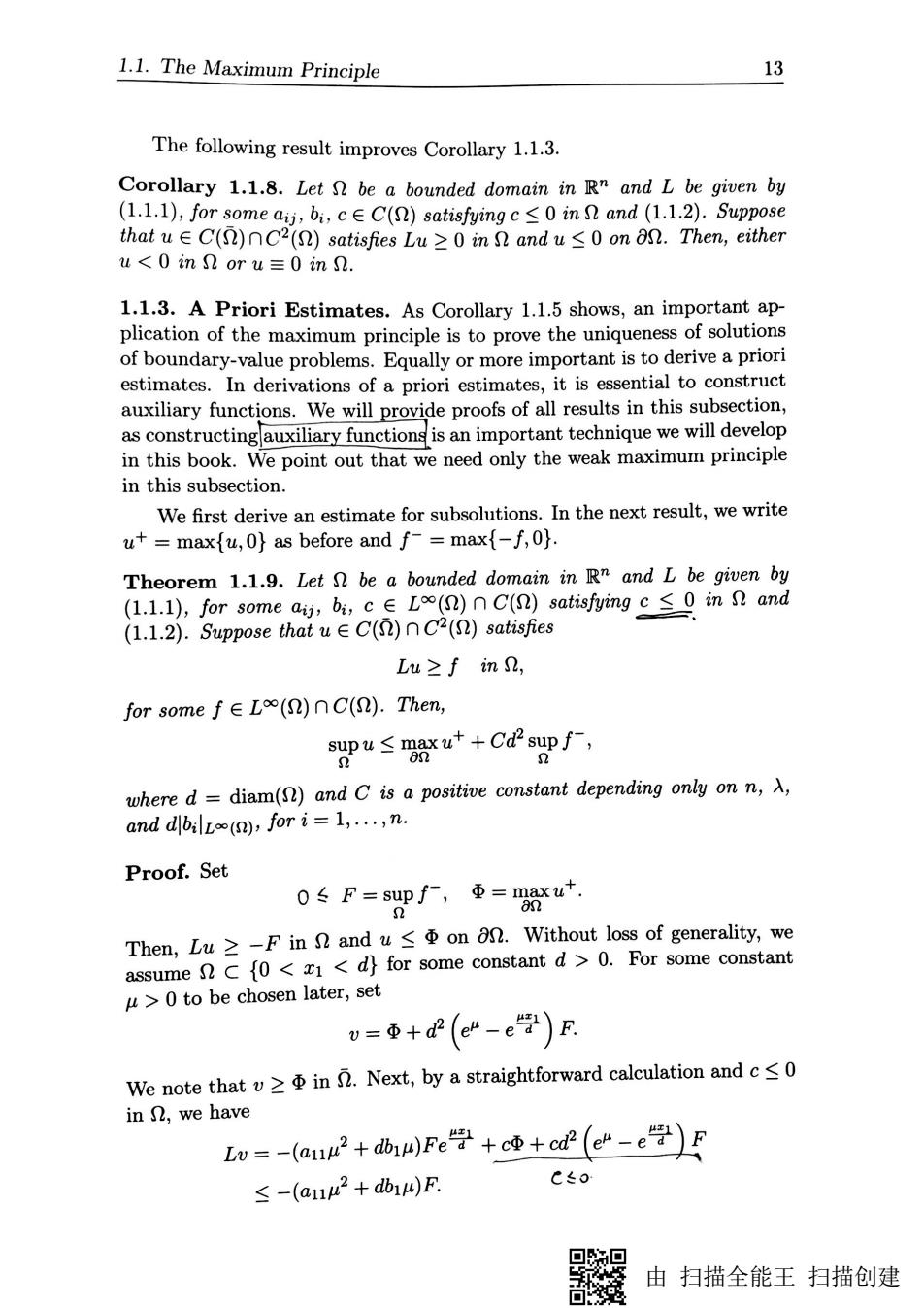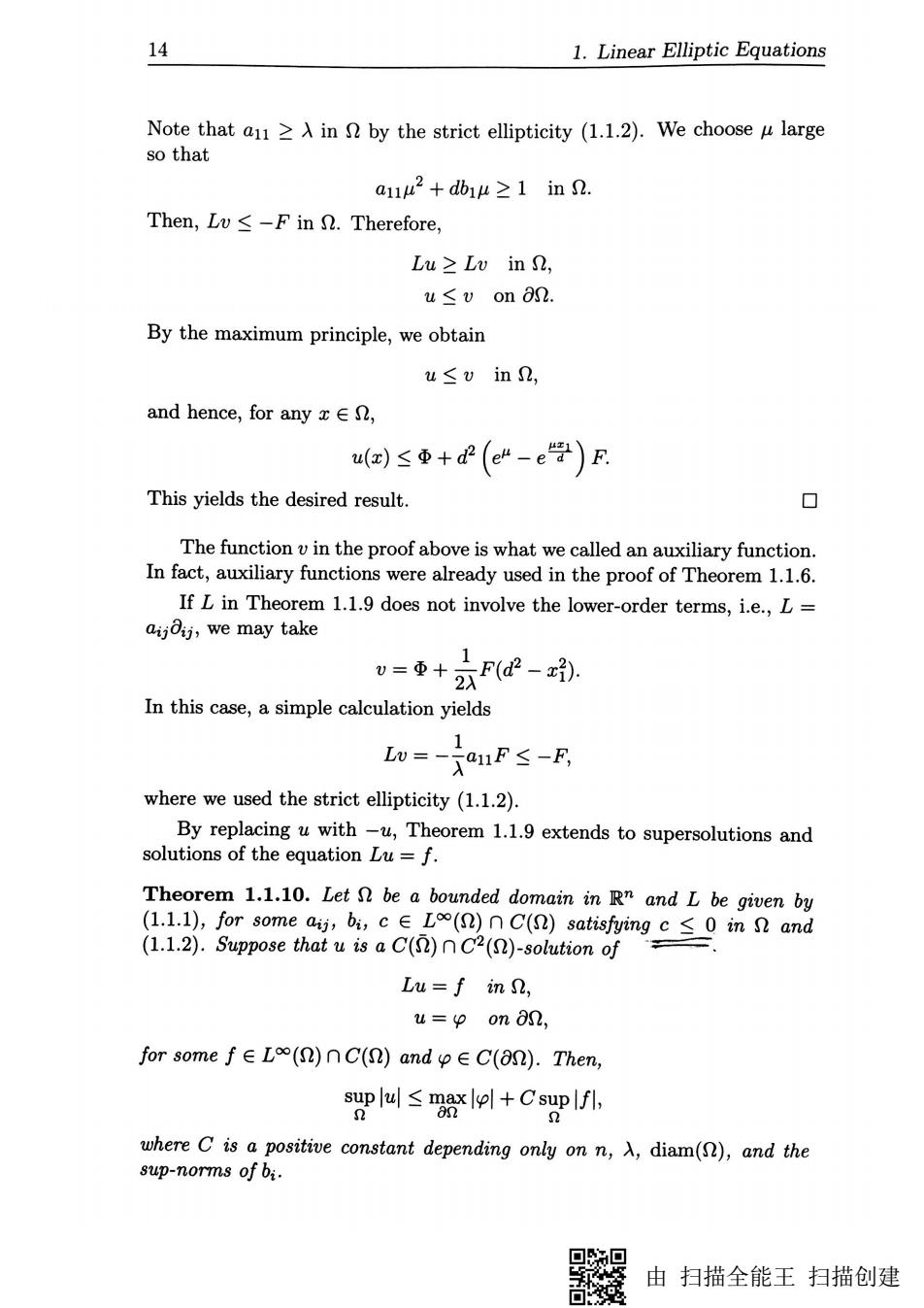
e 1.Linear Elliptic Equntions In view of (ro)=0,v attains at ro its maximum in D.Hence,we obtain mnl≥. and then 0w2- ()=2cpRe-e>0. This is the desired result. ◇ Theorem 1.1.6still holds if we for Bany bounded domain which satisfies an interior sphere condition at roea,namely,if there exists a ball B C with ro E B.This is because such a ball B is tangent to on at ro.We note that the interior sphere condition always holds for C2-domains. Now,we are ready to prove the strong maximum principle due to Hopf 8 Theorem 1.1.7.Let be a bounded domain in R"and L be given by (1.1.1),for some bcC(S)satisfvingein and (11.2).Suppose that u E C()C2()satisfies Lu 20 in S.Then,u attains only on 89 its nonnegative marimum in S unless u is constant. Proof.Let M be the nonnegative maximum of u in and set D={x∈2:u(x)=M}. We prove either D=0or D=by contradiction.Suppose D is a nonempty relat: ve such that oBnD0.In fact,we may choose a point z.\D with dist(.D)<dist(.,0)and then take the ball centered at z.with the radius dist(.,D).Suppose.Obviously,we have Lu≥0inB and u(x)<u(xo)for any x∈B and u(xro)=M≥0. By Theorem 1.1.6,we have 0ew>0 where v is the exterior unit normal to B at to.On the other hand,xo is an interior maximum point of u in This implies Vu(xo)=0,which leads to a contradiction.Therefore,either D=0 or D=.In the first case,u attains only on on its nonnegative maximum in while in the second case, u is constant in s. □ 由扫描全能王扫描创建
由 扫描全能王 扫描创建

1.1.The Maximum Principle 13 The following result improves Corollary 1.1.3. Corollary 1.1.8.Let be a bounded domain in R"and L be given by (1.1.1),for some aii,bi.cC(S)satisfuingc<0 in and (1.1.2).Suppose that u∈C()nC2()satisfies Lu≥0 in and u≤0oman.Then,either u<0 in n or u=0 in 1.1.3.A Priori Estimates.As Corollary 1.1.5 shows,an important ap plication of the maximum principle is to prove the uniqueness of solutions of boundary-value problems. estimates.In derivations of a priori estimate ssential to construct auxiliary functions.We will provide proofs of all resultsi this subsection as constructingauxiliary functions is an important technique we will develop in this book.We point out that weneed onlythe weak maximum principle in this subsection. We first derive an estimate for subsolutions.In the next result,we write ut=max{u,0}as before and f-=max{-f,0). Theorem 1.1.9.Let be a bounded domain in R and L be given by (1.1.1),for some aij,bi,c ∈Lo()nC()satisfying c≤0 in n and (1.l.2).Suppose thatu∈C()nC2()satisfies Lu≥finn, for some fL()nC().Then, sDw≤r8xu++Cd supf-, where d=diam(S)and C is a positive constant depending only on n,A, and dlbilL∞(,fori=1,,n. Proof.Set 0←F=swPf,西=8x+ Then,Lu≥-F in and u≤重onan.Without oss of generality,we assume c{<1<d}for some constant d>0.For some constant >0to be chosen later,set u=Φ+d(e-e学)F We note that v≥ΦinD.Next,by a straightforward calculation and c≤0 in we have Lw=-(ar2+db)Fe学+c中+a(e-e学)F ≤-(a1142+db1)F cso g 由扫描全能王扫描创建 ▣
由 扫描全能王 扫描创建

14 1.Linear Elliptic Equations Note that a1l≥入in2 by the strict ellipticity(1.l.2).We chooseμlarge so that a1142+db14≥1in2. Then,Lv <-F in Therefore, Lu≥Lv in S, u≤vona2 By the maximum principle,we obtain u≤vin2, and hence,for any x∈n, u()≤电+d(e-e学)r This yields the desired result. ◇ The the proof above is what we called an auxiliary function In fact,auxiliary functions were already used in the proof of Theorem 1.1.6. If L in Theorem 1.1.9 does not involve the lower-order terms,i.e.,L= aijoij,we may take =+2F2- In this case,a simple calculation yields Lw=-a1F≤-R where we used the strict ellipticity(1.1.2). By replacing u with-u,Theorem 1.1.9 extends to supersolutions and solutions of the equation Lu=f. Theorem 1.1.10.Let be a bounded domain in Rn and L be given by (1),for some)satising i and (1.1.2).Suppose that u is a C()2()-solution of Lu=f in, u=y on 8n, for some f∈L()nC()andp∈C(an).Then, sP叫≤2xlol+CsupIfl, where C is a positive constant depending only on n,A,diam(),and the sup-norms of bi. 由扫描全能王扫描创建
由 扫描全能王 扫描创建

1.1.The Maximum Principle 15 Next,we construct barrier functions for a large class of domains and erties of s tant role.We con erterior sphere condition atin the sese that there existsaball B()such that nBR(yo)=0,nBR(yo)={zo}. Lemma 1.1.11.Let be a bounded domain in R"satisfying an exterior sphere condition ato and L be given by(1.1.1),for some,bi, c()(1.1.3).Then,there exists a function wo EC()nC-(S)such that Lwxo≤-1inD and,for any x∈n\{xo}, 0xo(xo)=0,wxo(x)>0, where wo depends only on n,A,A,the Lo-norms of bi,diam(),and R in the exterior sphere condition. Proof.Set D-diam().For the given,conider an exterior ball BR(y)with BR(y)n={ro}.Let d(z)be the distance from x to aBR(y); i.e., d()=l-yl-R.s dot (xK)diam Then,for any x∈, 0<d(x)<D. Consider a C2-function defined in [0,D),with ()=0 and>0 in (D).Set w=(d)in S. We now calculate Lw.A direct calculation yields ad6-- axd()= z-3 Hence,IVdl=1,aijoidojd >A,and 1 1 doyd 六会司 nA 入 R Next, 8w='id,8ijw="8idojd+ijd. Then, Lw =v"aijoidojd+(aijdiid+bidid)+co. 用别c。 47o 由扫描全能王扫描创建 ▣
由 扫描全能王 扫描创建

16 1.Linear Elliptic Equations We now require>0 and "<0.Hence, e≤w+(42+ where We write this as Lw≤λ("+aw+b)-1, where R We need to find a function in [0,D)such that w"+a+b=0in(0,D), "<0,'>0in(0,D),and(o)=0. First,general solutions of the ordinary differential equation above are given by 表尺叭是匠 (④=-8d+C-gea4 a 帝? for some constants Ci and C2.For (0)=0,we need C1=C2/a.Hence we have,for some constant C. =-a+-e, a which implies v@=cew-&=e(c-&) "(d)=-Cae-ad. In order to have i D),we need C Then,i (0,D),and hence()=0 in (0,D).Therefore,we take 网=-2+总0ce01-6叫 平祖式美光然风花 -8a-6- Such a satisfies all the requirements we imposed. Now we estimate the modulus of continuity of solutions with the help of barrier functions constructed in Lemma 1.1.11. 由扫描全能王扫描创建
由 扫描全能王 扫描创建